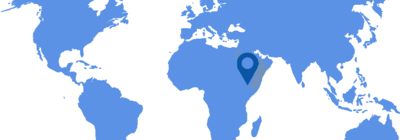IMPACT
From January 2024 to July 2025
-
Explosive Ordnance Risk Education (EORE) teams funded by UNMAS have reached 90,179 beneficiaries (26,009 girls, 28,829 boys, 18,588 women, 16,753 men) in Afar, Amhara, and Tigray. A total of 99 Explosive Hazard Awareness Training sessions have been provided to 1,545 humanitarian personnel (3,313 women, 1,214 men) from various UN agencies, funds, and programmes, as well as from NGOs, contributing to increased safety and security for aid workers.
-
UNMAS, through its national Implementing Partner, conducted Training of Trainers to 81 facilitators in Afar and Tigray. The trained community focal points now have the tools and capacity to deliver life-saving EORE sessions to community members.
-
UNMAS technical personnel deployed to Afar, Amhara and Tigray regions and assessed 263 areas (82 woredas) reported by humanitarian partners as suspected of explosive ordnance contamination, with 1,504 such items being reported, including among others, 671 projectiles, 111 rockets, 446 mortars, 141 fuses, 17 air dropped bombs, 12 grenades, 7 anti-personnel mines and 45 small arms ammunition. 722 items have since been removed for disposal, while 782 items were marked and reported to authorities.
ABOUT
Ethiopia has experienced a series of internal and international armed conflicts throughout its history, leaving a legacy of landmines and explosive remnants of war (ERW) scattered throughout the country. According to the latest transparency report that Ethiopia submitted under the Mine Ban Convention, the remaining unaddressed contamination totals 125,177,647 square metres.
The outbreak of conflict in November 2020 between the central government and the regional authorities of the Tigray region, which spilled over into the neighboring Afar and Amhara regions in 2021, has added new explosive ordnance contamination that poses an immediate threat to life and livelihoods. Since January 2020, 1,635 victims of explosive ordnance have been reported (183 girls, 852 boys, 153 women, 423 men) in northern Ethiopia, although not all cases have yet been verified. It is believed that many other accidents go unreported. Initial analysis shows that children make up more than 64% of all known casualties.
CURRENT ACTIVITIES
Explosive Ordnance Threat Assessment
UNMAS personnel have deployed to Tigray, Afar and Amhara regions to conduct explosive risk assessments in humanitarian partners’ areas of intervention. In 2024, at EMAO's request, UNMAS facilitated the release of 600 square kilometres of land that had been erroneously recorded in the EMAO database, in accordance with international standards and best practices, thereby ensuring the land was returned to the community for development.
UNMAS rapid assessments have also enabled the resumption of humanitarian aid operations, such as food distribution by NGO partners. Since July 2023, UNMAS technical teams in Amhara, Afar and Tigray have conducted 263 assessments of areas reported by humanitarian partners with potential explosive ordnance contamination. Since June 2025, explosive ordnance assessments have been undertaken in 11 woredas (33 Kebelles included) in Amhara Region. UNMAS assessment and explosive hazard awareness training enabled the safe reconstruction of 29 schools, 15 health posts and 4 police stations — acting as a force multiplier in restoring essential services. By enabling the resumption of educational services and the establishment of law enforcement facilities, UNMAS interventions contribute to creating conditions for stability and a foundation for broader recovery and reconciliation efforts.
Explosive Ordnance Risk Education (EORE)
UNMAS delivers EORE to humanitarian personnel to facilitate the safe delivery of aid in contaminated areas. In partnership with local implementing organizations, UNMAS also provides risk education tailored to gender, age and diversity considerations for at-risk populations. This comprehensive approach targets local communities, internally displaced persons and returnees across northern Ethiopia. Additionally, through cross-border coordination with UNHCR and UNMAS Sudan, risk education has been extended to Tigrayan refugees in Sudan.
Humanitarian Coordination
UNMAS leads the Mine Action AoR of the humanitarian architecture, ensuring mine action partners coordinate needs assessments and operations, share analysis, establish links with other key sectors such as Child Protection, Education and Health, and jointly advocate for increased access to resources.
Technical Assistance & Capacity Development
UNMAS is providing technical assistance to EMAO and the mine action sector to develop quality management, national mine action standards, field monitoring and data management capability - including to collect and analyze data through an Age, Gender and Diversity lens - as well as its operational capacity to conduct explosive hazards survey.
FUNDING
UNMAS is grateful for the direct contribution of donors to enable its mine action activities in Ethiopia. From January 2024, UNMAS operations relied on generous contributions from the Governments of Canada, Denmark, Korea, Japan and the Central Emergency Response Fund (CERF).
UNMAS Ethiopia currently seeks funding to consolidate its humanitarian mine action presence in northern Ethiopia and provide the necessary technical assistance and capacity development intervention for EMAO to manage and regulate the mine action sector in Ethiopia throughout 2026.
Data as of September 2025.



